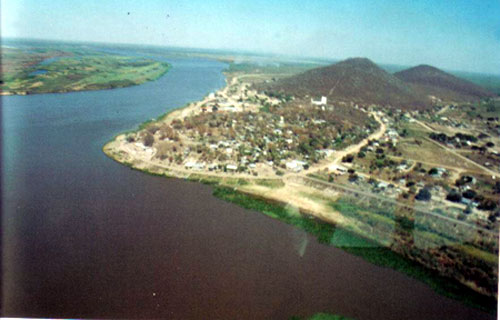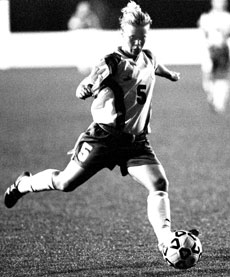I set out in late May on a leisurely journey to the American West by car. Among other things, I wanted to witness first-hand the political reality of Red America — a reality I don’t often confront in the blue isthmus of Austin, Texas. My journey started in Austin and ended up in San Francisco, two cities known for their liberal inclinations, though neither is far from Republican strongholds. Austin and San Francisco are both high rent, hip towns populated by a lot of people that fit my demographic — young, white, college-educated liberal Democrats — who, truth be told, have little interest in penetrating the mentalité of the conservative heartland.
As New York Times columnist David Brooks might say, they’d rather vacation in Tuscany than Tucson.
Red America shouldn’t have been such a mystery to me. After all, I grew up in Tulsa, Oklahoma, a place John Gunther called “the most conservative city in America,” in Inside USA. Tulsa is the kind of place where the first question people ask outsiders is “What church do you go to?” Voting Republican is not something you decide to do out of free will; it’s a civic obligation, like getting a library card or picking up litter.
Still, the shock of the November election remains with me. Even though I grew up with them, and count of them as family members and friends, I still wonder: Who the hell are these people who reelected George W. Bush?! If, as Thomas Frank claims in What’s the Matter with Kansas, Americans are suffering from a “species of derangement” that allows them to vote against their own best interests, what does this derangement look like on the ground?
This is my travelogue of the people and places of the Red Sea:
Somewhere around Mason, Texas, the inevitable happens. I have been listening to the Austin-based NPR affiliate, KUT, when the crackle and hiss of the weak signal becomes unbearable. I push the dial further to the left, hoping to hear more about the scandal of the day, the “Downing Street Memo,” which supposedly proves that the Bush Administration was attempting to “fix” intelligence to support the invasion of Iraq in 2003.
After weeks of ignoring the memo, journalists were starting to pay attention. The memo was the “smoking gun” that proved the Administration had deceived the American public in the run up to the war.
I listen for more, but no luck. Monopolizing the left side of the dial is what sounds like a college rock band, with a low-fi sound and a jangling guitar riff. When I listen closely, though, I hear earnest lyrics about Jesus and the young rocker’s personal relationship with the Lord. It is “alternative Christian,” a bizarre palimpsest of the Pixies or Nirvana, but with saccharine lyrics about being reborn in Christ.
I push the dial rightward, hoping to get another slice of the airwaves — maybe more on the Memo. Here I encounter Toby Keith, a fellow Oklahoman who has his own take on international affairs. In a song called “Courtesy of the Red, White, and Blue,” Keith warns “the terrorists” (whoever they are in west Texas) that he will personally “put a boot up your ass / it’s the American way.”
AM radio isn’t much better: Rush offers predictable rants about Hillary, Hannity vents about liberal judges, and a particularly vile shout show host named Michael Savage offers his $1.02 about “politically correct” professors. Nothing about Downing Street.
In the afternoon, hunger overtakes me. I am in the vicinity of Llano, Texas — pronounced “Laan-ah” by locals — and the world famous Cooper’s BBQ, so I make a detour. I once read a book by Larry McMurtry in which the Texan said that he would drive 100 miles for a good steak, so I figure a half-hour’s detour for the thickest pork chops ever carved from a pig is worth the trip.
Cooper’s has approximately seven 20-foot-long rows of BBQ pits that smoke every conceivable kind of meat: sausage, brisket, chicken, turkey legs. I think you can even get ostrich. You point to the meat you like, and a huge man in Wranglers pokes it with a sword-like instrument, dips it in some sauce, and then throws it on a plastic tray. If you get your food to go, the good people at Cooper’s put it in an over-sized cardboard box — the kind that liquor stores often use. They encourage you to take an entire loaf of white bread, a 20-ounce Styrofoam cup of beans and a roll of paper towels — for free! It is all excess and dressed-down decadence: what Texans like to call “Texas-sized.”
It is also wasteful and inefficient, of course, but to call attention to the vast amounts of waste generated would come off as un-Texan, and by extension, un-American. A pickup truck in the parking lot has a bumper sticker that reads: “Piss off a liberal: Be happy!” Some eating establishments might be wary of offending patrons by announcing their politics, but Cooper’s has a Bush/Cheney bumper sticker affixed to the front door.
Two pounds of pork chops later, I am back on the road. Long stretches of nothing. Dusty, low-slung towns. Few people visible outdoors, apart from Mexican construction and lawn workers. Even as I write this, I sense something’s wrong with my observation. Texas is now a “majority-minority” state and Hispanics are the largest minority, so of course I would see a lot of brown-skinned folks. It’s just that I don’t see any white people. That’s not a problem, of course, but as I approach the border, I see bright blue “Viva Bush” yard signs. My stomach churns pork.
Contrary to popular belief, a handful of counties outside of Travis (where Austin is located) voted for Kerry last year. Most are along the Mexican border. About seven hours west of Austin, I am in one of these counties: Presidio.
The county seat is Marfa, home to just over 2,000 people, but disproportionately famous for at least three reasons. One is a bizarre phenomenon known as the Marfa Lights, mysterious lights that flash on and off near a distant mountain range. Another Marfa attraction is the Paisano Hotel, where James Dean stayed while on the set of Giant, his last movie. Still another is the work of minimalist artist Donald Judd, who took over an abandoned Air Force base and converted it into a permanent art installation. The installation also houses an artists’ colony that attracts artists from around the world. At the Marfa Book Company, a sleek, cool downtown coffee bar/bookstore, I hear German and Australian accents.
The influx of artists has an odd effect on the locals. Down a side street, I spot an old white church that has been redecorated to look a cross between a Las Vegas-style wedding chapel and an artist’s studio. Pure kitsch. As I get out of the car to snap a photo, an old cowboy in dusty jeans, cowboy hat, and western shirt, nods to me. I am sure I have committed some faux pas.
“Hey, why don’t you take a picture of this?” he says, pointing to his scrappy house and rusted-out pick-up truck next door.
We talk and I find out he is the ex-sheriff of Presidio County, and — surprise — a Democrat. Now he works part-time as a cop in Marfa. Contrary to the stereotype of a redneck, he embraces the artists.
“As long as they pay taxes, let them do what they want. It’s good for a little town like this,” he informs me.
Outside of Marfa, and all along the New Mexico/Arizona border, I see more green U.S. Border Patrol SUV’s than civilian cars. I take two-lanes as close to the Mexican border as I can get. Twice — once in Texas and once in New Mexico — I see billboards spray-painted “The Minutemen.” The border feels militarized and eerie. It is blazing hot, and there are no signs of life except for the occasional torn piece of clothing on a barbed wire fence, probably left by an immigrant suffering from heat exhaustion. I begin to worry about breaking down: there are no towns for 50 miles and no cell phone signals.
On the way to California, I see sprawling towns all along the border that lack any visible water supply: El Paso, Las Cruces, Yuma, El Centro. Theses are booming places that feel part Mad Max, part Bed, Bath, and Beyond. Cruel, lifeless places that look like upscale versions of Falluja.
But the biggest surprise is that, in the middle of this blighted Red Sea, there are signs of life. Flagstaff and Tucson in Arizona. Santa Fe, New Mexico. Here I see people actually walking. Flagstaff, I read in the local paper, is resisting the invasion of a Wal-Mart Supercenter. Santa Fe, for all its hokey New Age vibe, has a unique character. I see more Subarus (the most popular car for Democrats) in Santa Fe than anywhere else in the country.
Days later I arrive in Las Vegas, a place I hope to never see again. This where the American species of derangement becomes a virus, making people look and behave like they’re on a Fox reality show for the living dead.
After four days of traveling I finally feel the cool breeze of the Pacific. I have come up from California’s Central Valley, a flat place of urban sprawl, smelly farms and unbearable heat. Another Red space.
On the horizon, I spy the red Golden Gate Bridge and thank God that the sky is still blue.
I think I’ll fly next time.
STORY INDEX
The writer
Russell Cobb, InTheFray Assistant Managing Editor
- Follow us on Twitter: @inthefray
- Comment on stories or like us on Facebook
- Subscribe to our free email newsletter
- Send us your writing, photography, or artwork
- Republish our Creative Commons-licensed content



















